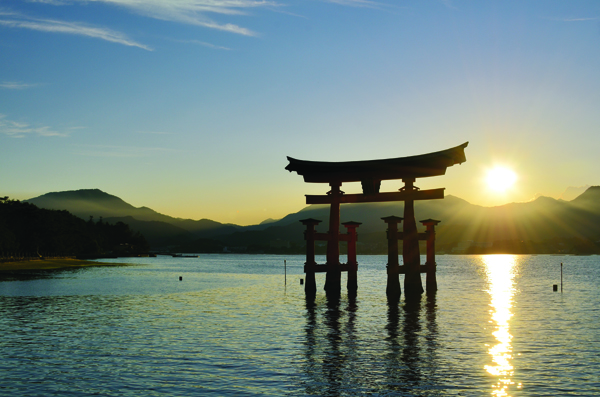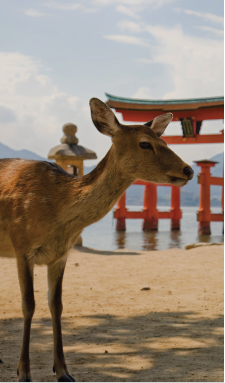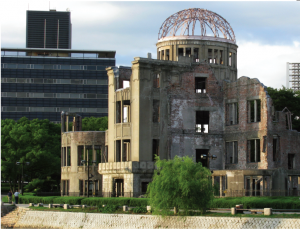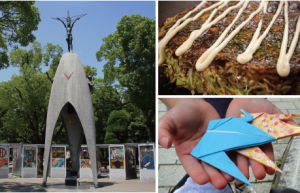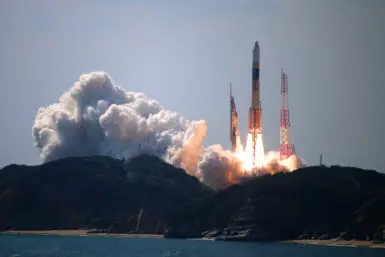At 8:15 on August 6, 1945 the industrial city of Hiroshima was hit by ‘Little Boy’ the world’s first atomic bomb to be used in war. In a blinding flash, 80,000 people were killed and 69 per cent of the city was completely destroyed. In the bomb’s aftermath, thousands upon thousands of people succumbed to severe injuries and diseases including burns, radiation poisoning and leukemia. In the next three months, Hiroshima’s population plummeted from 400,000 to just 136,000.
Yet rebuilding efforts began as soon as two days after the bomb’s detonation. It was first said that nothing would grow and the affected ground would be left desolate for up to 75 years. But by the following spring, red canna flowers began sprouting through the rubble, providing much hope to survivors. By 1955, the population had even overtaken pre-war levels.
A large part of the reconstruction, just as important as the healing process, centered around how to correctly memorialise the bombing and those who lost their lives. The site eventually chosen to do this contained the only surviving building remnants in the city centre—the Hiroshima Exposition Hall, now known as the A-Bomb Dome, a UNESCO World Heritage Site, which was directly below the bomb when it exploded 500 meters from the ground. The surrounding area, which before the bomb contained 710 buildings and was one of the most bustling parts of the town, was converted into the Hiroshima Peace Memorial Park, housing the Hiroshima Peace Memorial Museum, the Flame of Peace and the Memorial Cenotaph. And this is what the majority of Hiroshima’s millions of yearly visitors come for.
Visiting Hiroshima today, it is hard to believe that this beautiful and serene town was once reduced to rubble and ash. The road between the airport and the city winds through the Chugoku region of western Honshu, and is surrounded by a mountainous, green landscape, scattered with rice paddies and pine plantations.
The town itself, nestled in the Chugoku mountains, welcomes visitors with wide, tree-lined boulevards and streets, an abundance of well-tended parks (over 700 of them), and a host of activities that not only present a very factual and unbiased retelling of the events surrounding the use of the world’s first atomic bomb, but demonstrate how the city and its survivors pulled through. While Hiroshima City is actually very pretty and modern looking, constant reminders that these qualities came at a horrific cost are around every corner in the form of signposts, tourist materials, and memorial plaques.
Interestingly enough, the progressiveness of the city also extends to the thinking of its citizens. Here is an entire city of people possessing an awareness of how Japan and its people fit into history and the modern-day world on an international scale—something that is usually only observed in well traveled Japanese and not in mainstream Japan. Nor do the citizens of Hiroshima lay any blame or hold anyone accountable for the atomic bomb.
Instead, Hiroshima imparts on its visitors a message of peace. Time spent viewing images and film and reading about personal stories on display in the Hiroshima Peace Memorial Museum makes the message perfectly clear—please do not let others suffer as they have suffered and don’t ever let history repeat itself.
Visit the A-bomb Dome
Not many places can turn a symbol of destruction into a tourist attraction. Hiroshima’s most iconic structure, the Hiroshima Prefectural Industrial Promotion Hall, dubbed the ‘A-bomb Dome’ was designed by a Czech architect, Jan Letzel. At 8:15 on August 6, most of the city was destroyed in an instant, but the stone and steel structure at ground-zero survived. In 1996 the remains were named a World Heritage Site by UNESCO — to the initial protests of the American and Chinese governments who were concerned that turning the site into a shrine would remove all the context that led up to the tragic bombing. Thankfully Hiroshima is a peaceful city today and memories of war have been replaced with a campaign for the abolition of nuclear weapons and the promotion of world peace.
Contemplate the Peace Park
Not many places can turn a symbol of destruction into a tourist attraction. Hiroshima’s most iconic structure, the Hiroshima Prefectural Industrial Promotion Hall, dubbed the ‘A-bomb Dome’, was designed by Czech architect Jan Letzel. At 8:15 on August 6, most of the city was destroyed in an instant, but the stone and steel structure at ground-zero survived. In 1996, UNESCO named the remains a World Heritage Site – to the initial protests of the American and Chinese governments, who were concerned that turning the site into a shrine would remove all the context that led up to the tragic bombing. Thankfully Hiroshima is today a peaceful city, and memories of war have been replaced by a campaign for the abolition of nuclear weapons and the promotion of world peace.
Walking across the stone bridge to the impressive Kenzo Tange designed Hiroshima Peace Memorial Park is a must. There you will find a number of monuments for peace; a tower erected for the repose of the souls of the victims of the atomic bomb, a memorial tower, and a fountain with an eternal Flame of Peace. Flocks of doves, a symbol of peace, are often seen flying around the park.
Fill up on Okonomiyaki
Hiroshima’s favorite food is the any-way-you-like-it pancake-like concoction of egg, batter, cabbage, pork, vegetables, noodles and sauce cooked on a hot plate in front of you. The DIY nature of the dish makes it appealing to all, as the ingredients and flavour can be changed by individual preference. There are okonomiyaki restaurants all over Japan, but for the real Hiroshima-yaki deal, head to Okonomi-mura – a three-floor building with over 25 stalls to choose from.
Relax on a boat cruise
Hiroshima, literally means ‘wide island’, and it is flanked by rivers and canals. If you want a break from the town, head to one of the many river cruises for a relaxing afternoon on the water.
Visit World Heritage sites on Miyajima
Miyajima, meaning Divine Island, has a history dating back to the year 593, when Empress Suiko took the throne, and the Istukushima Shrine was built. The island is home to one of the most photographed vistas in Japan – the torii set out in the Seto Inland Sea, about 200 meters offshore from the Itsukushima Shrine (another UNESCO World Heritage Site). The red gate, made of camphor wood, stands at 50 feet high, with its two pillars each having a circumference of 10 meters. The best time of day to see this is during high tide, as the torii looks to be floating on the surface of the sea. At high tide, some boats cruise through the gate.
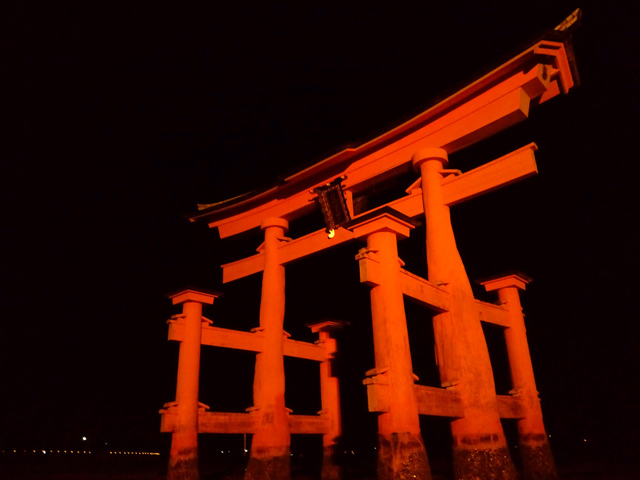
Being able to walk out to the torii at Miyajima during the night low tide is one of the best reasons to do an overnighter.
Watch the Carp play ball
Baseball is fun anywhere in Japan, but the noisy crowds and party-like atmosphere are maximized when Hiroshima’s local team the Carp play against the Tokyo Giants or Hanshin tigers. Tickets start at just ¥1,500. What better way to soak up the local culture than with a beer in hand?
Go back in time at Hiroshima castle
Originally constructed in the 1590s, the ‘Carp castle’, was destroyed in 1945. A replica of the original was rebuilt in 1958, which now serves as a museum of Hiroshima’s history prior to World War II.
See global art in a local museum
The Hiroshima Prefectural Art Museum displays artworks from the likes of Salvador Dali and Picasso, as well as contemporary Japanese artists. If you have time to spare and want a dose of global visual culture head here.
Zoom-Zoom to the Mazda factory
In 1920 Toyo Cork Kogyo was founded in Hiroshima, the company went on to make machine tools and in 1931 the first three-wheeled truck rolled off the production line. Today, the Mazda Group, as it is now called creates world-class automobiles. The process and history of one of Japan’s industrial giants can be explored at the Mazda Museum. A visit here may be the perfect antidote to an overdose of World Heritage sites.
Hiroshima is a four-hour shinkansen ride from Tokyo station. By air, it takes 90 minutes from Haneda Airport to Hiroshima Airport, and then just under 60 minutes by limousine bus to Hiroshima City.
For more information, see: Hiroshima Navigator site, and the Hiroshima Peace site.

